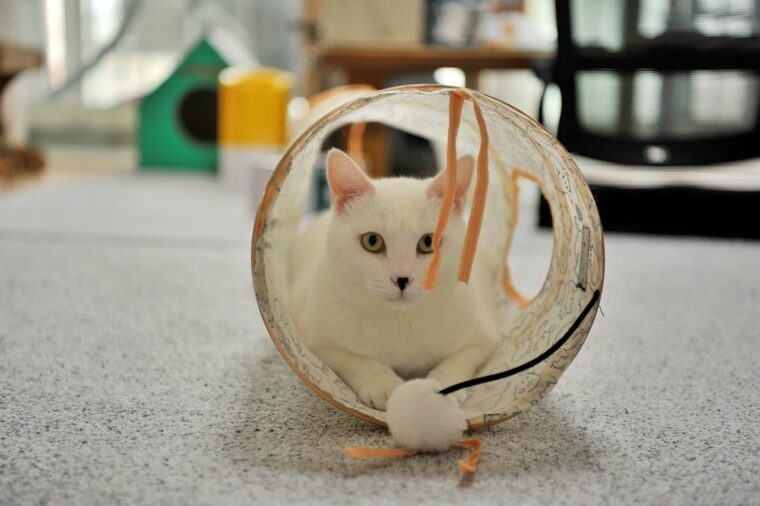
Cats are fascinating creatures. Intelligent, affectionate, and often independent, cats differ from dogs in that they don’t usually consent to going on walks or following their owners from room to room. Each cat is vastly different, but each needs mental stimulation to enrich their lives as much as possible. With this in mind, here are 16 great ways to provide fun and mental stimulation for your wonderful cat.
The 17 Ways for Providing Mental Stimulation for Cats
1. Talk
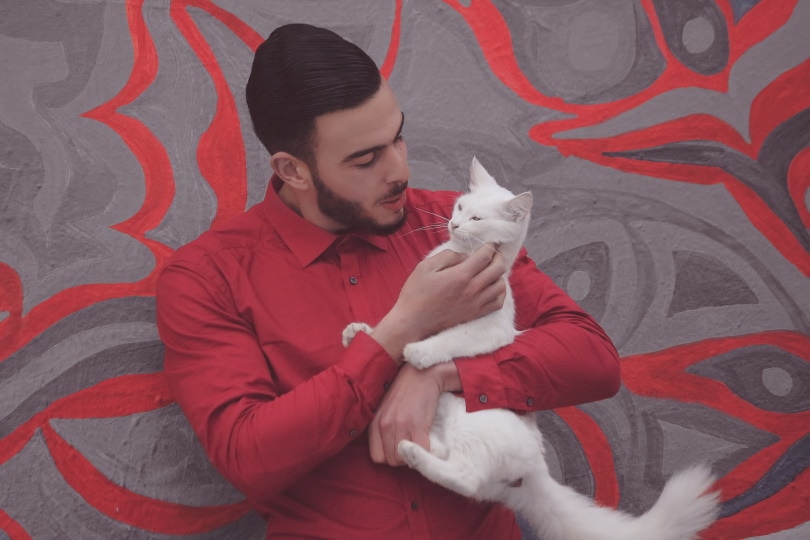
Despite seeming very simple, talking to your cat regularly will provide it with mental stimulation but will also help strengthen the bond between you and help it feel more secure.
Cats are great communicators, and while they are not as visually expressive as dogs, if you pay close attention to their body language (and even vocalizations), you can read a lot about how they’re feeling.
Cats exclusively meow to humans, meaning they don’t meow to any other species, including their own. This shows that talking to your cat and listening to it talk back can effectively engage it.
2. TV Time
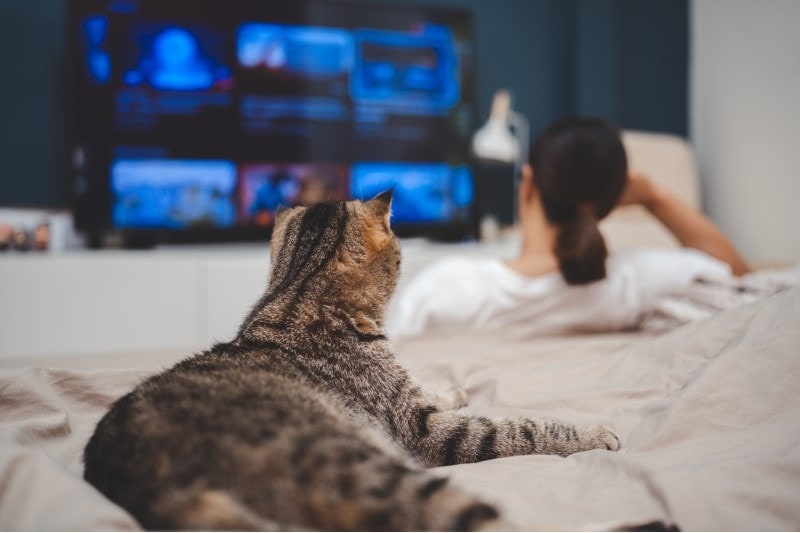
It seems strange, but many YouTube videos are available specifically for entertaining your furry feline friends. Videos such as wild birds, laser pointers, and mouse animations are all free to watch, with music and noises included.
An important thing to remember when showing your cat a video is to supervise them while doing so. If your cat gets really into it, it may bat the screen with its paw. Depending on what you’re watching the videos on, this could destabilize a TV set and be dangerous, so full supervision is strongly recommended.
It’s also essential to offer your cat something to pounce on and catch afterward, as cats have a high prey drive and may be frustrated if they can’t “get the kill” once the TV time is over.
3. Toy Rotation
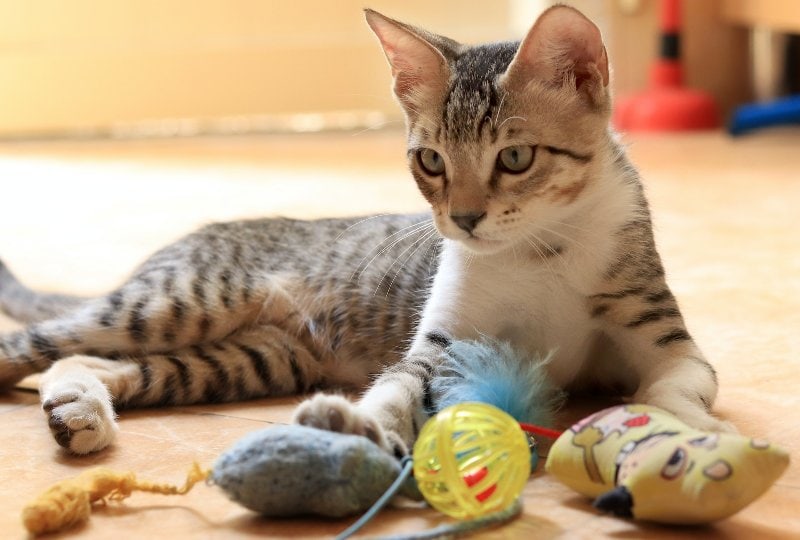
Like people, cats can quickly become bored with the same toys. By rotating toys of a few different types (such as feather chasers, toy mice, and kicker toys), you will enrich your cat’s life by allowing it to display other natural behaviors and stimulate its mind by allowing it to think about different problems.
A weekly toy rotation schedule is a good idea, as it allows you to mix and match different toy groups while checking any used toys for damage (which, if present, must be thrown away and replaced).
4. Cat Scratchers

Cat scratchers are more than just tools for satisfying a cat’s natural urge to scratch – they also offer valuable mental stimulation. When cats scratch, they’re not only maintaining their claws but also engaging in a sensory experience that exercises their minds. The textures and materials of scratchers activate their sense of touch, while the act of scratching itself provides a mental challenge and releases pent-up energy.
By introducing a variety of scratcher types, you can keep your cat mentally engaged. Scratchers with different textures, angles, and surfaces offer novel experiences that keep cats curious and entertained. This mental stimulation is especially important for indoor cats, as it mimics the mental challenges they would face in the wild. Ultimately, cat scratchers are a wonderful way to keep your feline companion mentally sharp and content.
5. Hide and Seek

Following on from our last point, hide and seek is an incredibly beneficial game to play with your cat, allowing them to flex their hunting skills safely and in a controlled way. Begin by grabbing a toy your cat loves and running around a corner while calling their name.
Waving the toy around the corner or wiggling it on the floor can simulate prey-hiding behavior, enticing your cat into the classic “bum wiggle” pose with pupils wide, ready to pounce. Moving from place to place and hiding with the toy can be a lot of fun for you and your cat as they try to hunt you down and get the toy.
Any activity simulating hunting stimulates your cat, as it provides excitement and a chance to indulge their prey drive. Remember to let your cat have the toy when the game is over since successful hunts are the only kind your cat wants.
6. Hidey-Holes

Cats are all about feeling safe and secure; nothing does this better than a beloved hidey-hole. Hidey holes can be homemade, such as out of cardboard boxes or large containers, and store-bought like this cute cat house with an added scratcher.
Playing with toys around the hidey-hole can be a great way to exercise your cat’s reflexes and judgment since they’ll think about where the toy might be when they can’t see it and jump out on it when they can.
7. Laser Pointer

Laser pointers are a great way to play with your cat if you have reduced mobility, are busy with another job, or just want to see them go crazy.
Laser pointers often come in different shapes, such as mouse and star shapes, so play around and find out which your cat prefers. This is best done in a darkened room (not completely dark), and flicking the laser can draw your cat’s attention and get them moving.
Again, when the game is over, make sure they can pounce on a toy to make the hunt successful; if not, it can cause frustration.
8. Obstacle Course
This one is entertaining for you and your cat. Let your creativity flow by creating a kitty obstacle course in your sitting room, using boxes, tunnels, and even shredded newspaper in boxes with hidden treats inside.
This activity increases your cat’s awareness of their surroundings, allowing them to hunt and find things using their sense of smell. You can also buy premade obstacle course components such as tunnels if you’re short on time and would rather buy one.
Even household items can be used to stimulate your cat mentally; this toy uses a simple mat to give your cat hours of fun.
9. Cat Trees and Vertical Space

Cats are natural climbers and feel safest when they can look out on their surroundings from a high vantage point. Excellent mental stimulation can be provided by placing cat trees or using your home’s vertical space, such as with cat shelves with bridges attached or perching points.
Just ensure that the area where the trees or shelves are placed is safe and away from windows or sharp corners (in case they fall). As cats get older, they may not be able to jump or climb as well as they once could, so make adjustments accordingly.
10. Treasure Hunt

Much in the same vein as an obstacle course, hiding some of your cat’s favorite treats around your home makes for a fun sniffing session for your cat. Giving your cat a treat at first can engage their brains and motivate them to find the treats, although some cats may need a little encouragement in finding the right place when you start.
Smelly treats work best for this, like these dehydrated whole fish treats (keep an eye out for bones with these). Remember where you put them and pick them up once you’re done, as some un-found treats may start to give off an odor if you forget about them!
11. Music
Music can be as entertaining to some cats as it is to us. Music (especially in the form of species-specific music, or music interspersed with human talking, such as a classical radio station) can be very mentally stimulating to cats, as well as giving them something to keep them company if they’re home alone during the day.
Music specially made for cats engages the parts of your cat’s brain associated with communication. Studies have shown that young and older cats were interested in this music more than human music, but middle-aged cats didn’t show as much interest in either.
12. Relaxing Touch
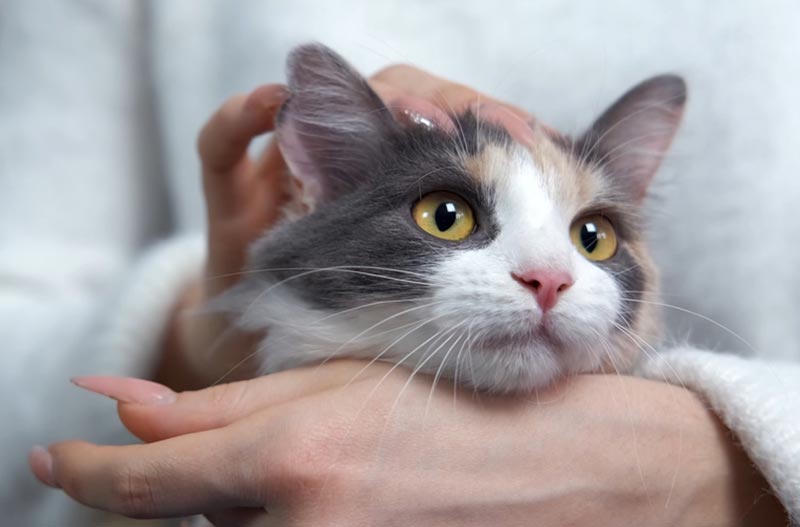
There’s nothing quite as relaxing to pet parents as having a cat purring away happily on your lap, and the same can be said for the cats themselves (as long as it is done on their terms).
Gentle, considerate petting can be very rewarding for your cat and can release hormones that decrease stress in both cats and humans. However, some cats are more sensitive than others and can be overstimulated by too much petting.
As long as you give your cat options and allow them to come to you when they want some affection, all will be well.
13. Puzzle Treat Dispenser
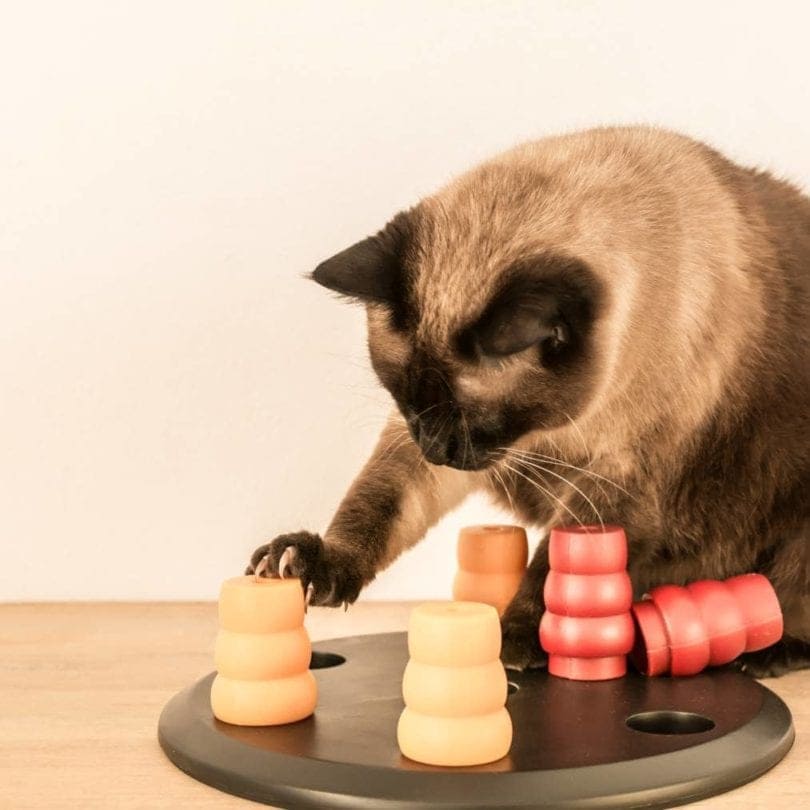
Cat puzzle feeders are another great way to enrich and stimulate your cat. Puzzle feeders and dispensers allow your cat to problem solve and work out the puzzles to get a reward, meaning that they’re actively using their brains to get a boost of endorphins once the puzzle is solved.
There are many types of puzzle treat dispensers: some of which you can buy and some that you can make at home. Cutting small holes in a bottle and filling it with treats can be an excellent puzzle dispenser for cats. Other dispensers range from balls or eggs that do the same thing to interactive and complex mazes.
14. The Humble Cardboard Box
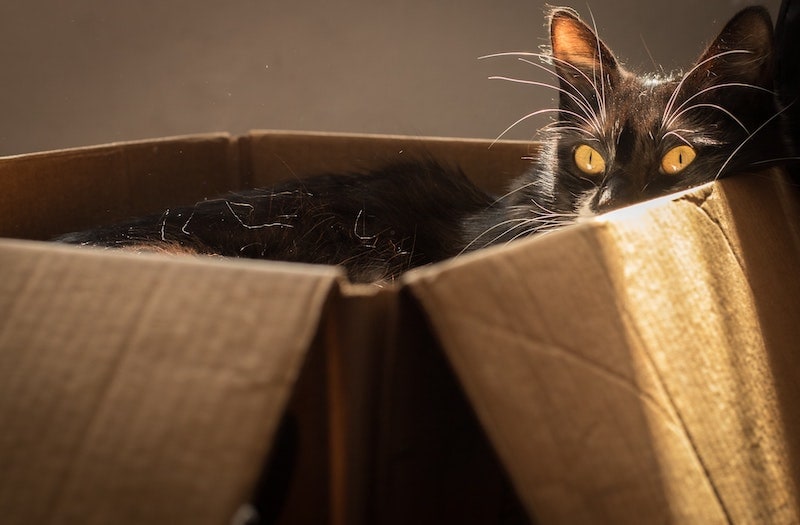
Sometimes, the best toys for cats are cardboard boxes. Cardboard boxes can be used to create mazes, toys, hidey-holes, puzzle feeders, or lucky-dip boxes. Still, most cats will sniff a box and sit in it because they derive comfort and security from enclosed spaces.
This allows your cat to engage with their surroundings positively, stimulating their brains and making them feel safe and happy, all at the price of a couple of dollars. They also have an interesting texture that cats will rub on and scratch at, supplying further stimulation in the form of natural, instinctive behavior.
15. Electronic Toys

There are so many choices for electronic cat toys you’re bound to discover one your cat can’t resist, whether it challenges them to get a reward or engages their hunting instincts and has them flying around the room.
Some toys like this feathered bird singer use realistic bird sounds to engage your cat and entice them to hunt, while this floor toy uses concealed motion to emulate prey hiding under a blanket, encouraging your cat to use its vision and pounce at the right moment to succeed at the hunt.
16. Catnip (or Silvervine)

The age-old image of a cat going crazy for catnip is a true one. Catnip comes from the Nepeta Cataria plant (the Catnip plant). When sniffed by your cute cat, the dried herb releases nepetalactone, which is a substance that activates euphoric neurons in a cat’s brain, making them extremely happy. Cats may rub on it, lick it, smell it, or roll all over it, while some may go bananas and run around finding every toy they can to play with.
Some cats don’t have this reaction, and no one is entirely sure why. Silvervine is another plant cats sometimes have a reaction to, due to the actinidine it releases, which has a similar effect as catnip but also can cause relaxation.
Catnip can be found in many forms, dried and loose for sprinkling, baked into treats, infused into sprays, or placed into cute toys. Silvervine is most often found in dried sticks that your cat can lick, chew, and rub on.
Catnip can really enrich your cat's life, especially if you choose a fun, well-built catnip toy. Our favorite option is Hepper's Catnip Stick Toy, which offers sturdy construction, 100% organic catnip fill, and a great range of colors. These toys are handmade in the USA and feature bite-proof double bagging.
At Pet Keen, we've admired Hepper for many years, and decided to take a controlling ownership interest so that we could benefit from the outstanding designs of this cool cat company!
17. Tricks
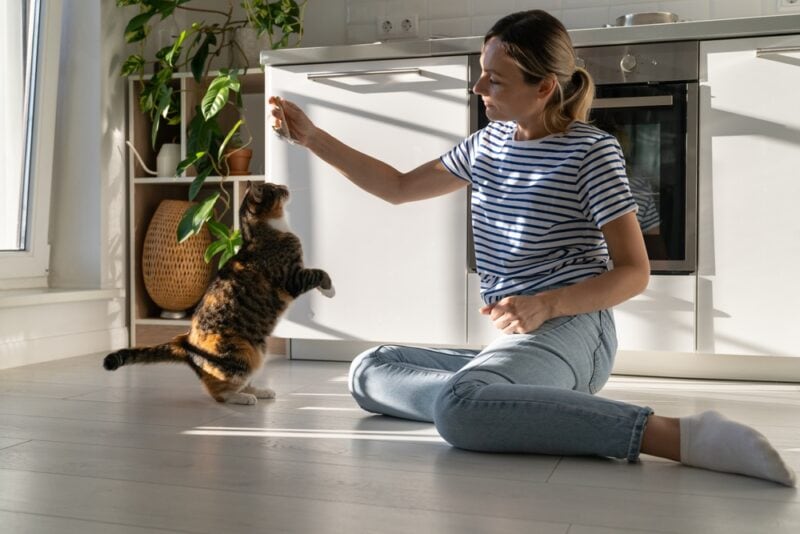
Cats are intelligent creatures that are more than capable of learning a few tricks. Interacting in a positive way with your cat will increase the bond between you and stimulate your cat’s brain by allowing it to learn a new skill.
While it’s usually reserved for dogs, a clicker can be a great way to teach your cat new tricks. It has to be said that training a cat to sit can be more difficult than teaching a dog; it’s more than worthwhile and provides hours of fun for you and your furry friend.
Why Do I Need To Provide Stimulation for My Cat?
Cats by nature are predators and hunters. Because of this, they have several behaviors that are innate and instinctual, meaning they must be performed as a normal part of their lives to keep them happy and healthy.
These include scratching, pouncing, climbing, and tracking. Not giving your cat enough mental stimulation can cause behavioral issues as well as stress and depression, both of which come with their own medical problems.
Conclusion
Using these ideas can ensure your cat has plenty of mental stimulation and provide opportunities for you to bond with them and ultimately enjoy your time together more.
Whether you decide to do a few or all, keeping an eye on your cat and going by what they want to do is essential. If your cat is forced to do something it doesn’t want to, it may have the opposite effect and cause undue stress.
Featured Image Credit: peter jung, Pixabay








